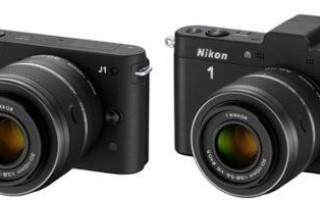Nikon V1 vs Nikon J1: comparative characteristics
Nikon V1 vs Nikon J1: comparative characteristics
Nikon's entry into the market of mirrorless cameras with interchangeable lenses last year was quite expected, but the announced models still surprised many. Nikon used a new system based on a relatively small sensor that is about 30% the size of the sensors typically used in DSLR cameras. Nikon has this system today represented by two models Nikon V1 and Nikon J1. The J1 was billed as an entry-level camera, while the V1 is aimed at slightly more advanced users. But both cameras are mainly intended for beginners who are moving from compact cameras and camera phones to a more complex model, but who are not satisfied with the large size of DSLR cameras.
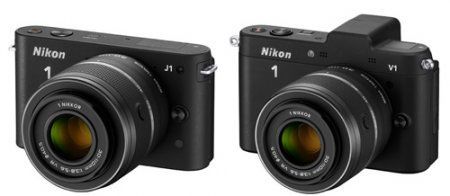
The main advantages of these models are the autofocus and burst shooting features. Both cameras have a so-called hybrid autofocus system, which combines phase detection autofocus with contrast autofocus, which, in principle, makes it possible, unlike other mirrorless models and other compact cameras, to shoot fast-moving objects in the same way as with DSLR cameras. The models also make it possible to take up to 60 full-frame photographs per second, for which the new Expeed 3 processor was used.
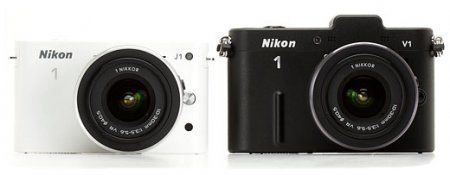
In addition to the released devices, Nikon also debuted four interchangeable lenses for these models (including a pancake lens, as well as a rather powerful superzoom), and also offered a number of updates for the V1. Unlike the rest of the market, which features cameras that are compact in size but have a large sensor, the System 1 has a small sensor in both size and resolution. With a matrix of 13.213.2 x 8.8 mm, there is a ten-megapixel sensor, which is the smallest among mirrorless cameras, except for the Pentax Q. At the same time, the crop factor results are 2.7. But on the other hand, the models cannot be called miniature and are approximately the same in size as the Panasonic DMC-G3 Sony NEX-7.
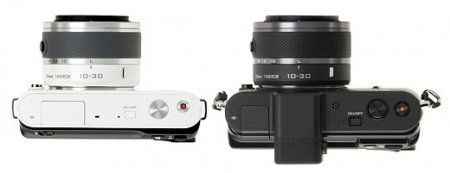
There is an important difference between V1 and J1. The V1 has a built-in 1440k dot electronic viewfinder, while the J1 does not have a viewfinder. However, despite the fact that the J1 model is simpler and more affordable, it still has the advantage over the V1, which is the built-in flash, which the V1 lacks. Although at the same time, the V1 compensates for this with a universal port for interchangeable flash. The V1 also has a higher resolution on the LCD display and a mechanical shutter (whereas the J1 only has an electronic one), which allows you to shoot at a higher frame rate, which is important when photographing moving objects. The mechanical shutter also allows you to use the flash at a shutter speed of 1/250, rather than 1/60, which the electronic shutter is basically unable to do.
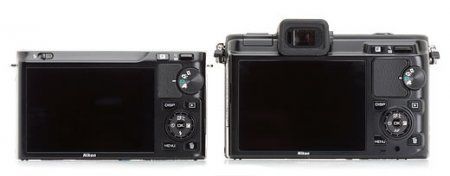
The V1 is slightly larger in size than the J1, even though the V1's viewfinder is not dedicated to the body. Both cameras have stereo microphone jacks. The button layout is virtually identical on both models, with the exception of the flash button on the J1. J1 has a button on the mode dial to turn on the flash, V1 has a special autofocus mode there. The V1 is equipped with a sensor to the left of the eyepiece that automatically switches the system from the LCD display to the viewfinder.
Nikon V1 Specifications:
— Matrix: 13.2 x 8.8 mm, 10.1 MP, CMOS
— Continuous shooting: 10, 30 or 60 fps
— Focus: Autofocus, single-point AF, auto-area, subject tracking, manual focus
— Shutter: Mechanical shutter with electronic control of the vertical stroke of the curtains, electronic, speed: 1/4000 to 30 in steps of 1/3 EV
— Exposure metering: matrix, center-weighted: metering in a circle with a diameter of 4.5 mm in the center of the frame, spot: metering in a circle with a diameter of 2 mm for the selected focus area
— Viewfinder: Electronic, 0.47″, TFT, 1440 thousand dots
— Zoom: 3.66x optical
- Image recording: NEF (RAW): 12 bit, compressed, JPEG
— Video recording: Full HD (1920×1080)
— Exposure compensation: From -3 to +3 EV in steps of 1/3 EV
— Exposure testing modes: Programmed automatic mode with flexible program; shutter-priority auto mode; automatic mode with aperture priority; manual; automatic scene selection
— Dimensions: 113 × 76 × 43.5
Nikon J1 Specifications:
— Camera matrix: 13.2 x 8.8 mm
— Light sensitivity: ISO: 100–6400
— Continuous shooting: 10, 30 or 60 frames per second
— Focus: autofocus, single-point AF, auto-area, subject tracking, manual focus
- Shutter: Electronic, Speed: 1/16,000–30 sec in 1/3 EV steps
— Exposure metering: matrix, center-weighted: metering in a circle with a diameter of 4.5 mm in the center of the frame, spot: metering in a circle with a diameter of 2 mm for the selected focus area
— Zoom: 3.66x optical
- Image recording: NEF (RAW): 12 bit, compressed, JPEG
— Video recording: Full HD (1920×1080)
— Exposure compensation: From -3 to +3 EV in steps of 1/3 EV
— Exposure testing modes: programmed automatic mode with flexible program, automatic mode with shutter priority; automatic mode with aperture priority; manual; automatic scene selection
Nikon 1
The Nikon 1 series of cameras is a whole family of models with removable optics.
The peculiarity of these models is the use of a relatively large matrix, consistently high operating speed, and, as practice shows, a wide selection of devices. The first models of this series appeared in 2011.
These were Nikon 1 V1 and J1 cameras, differing in the presence of a viewfinder, the ability to connect external flashes and the resolution of the LCD display. On this page we will look at newer models that are adding year after year in design and functionality.
Speed capabilities
The high-speed capabilities of cameras are the hallmark of the Nikon 1 series of models.
The ability to shoot photographs at speeds of up to 60 frames per second with full resolution, simultaneous shooting of videos (with a resolution of 1920x1080 pixels and a speed of up to 60 frames per second) and photographs, turning one picture into a series , from which you can choose the optimal frame - a list of just a few camera capabilities (for more details, see the video at the end of the article).
The hybrid autofocus method (using the accuracy of the contrast method and the speed of the phase method) is today an important advantage of a high-speed camera.
We also note that all models can record photos in RAW format and have an HDMI output for transmitting high-definition video to a compatible TV.
Nikon 1 V2
 The Nikon 1 V2 model, like its predecessor V1, retained in its design a built-in electronic viewfinder with a resolution of 1.4 million dots (which is its unique feature compared to other Nikon 1 cameras).
The Nikon 1 V2 model, like its predecessor V1, retained in its design a built-in electronic viewfinder with a resolution of 1.4 million dots (which is its unique feature compared to other Nikon 1 cameras).
The increased resolution of the CMOS matrix measuring 13.2x8.8 mm (which is true for all models in the series) and the clarity of 14 megapixels also distinguishes Nikon 1 V2 from Nikon 1 V1.
The ability to take continuous shots at a speed of 15 frames per second (with automatic focusing of each frame) or up to 60 frames per second (with fixed focus) indicates the high speed capabilities of the model.
 |
 |
An important advantage of the devices is the presence of both mechanical and electronic shutters (other models in the series have only an electronic version).
Support for a Wi-Fi adapter, a hot shoe for connecting external flashes, microphones and GPS receivers turns the Nikon 1 V2 into a universal device that can satisfy the most demanding needs.
Nikon 1 J2, Nikon 1 J3
Nikon 1 J2 and J3 cameras are more compact and lightweight. They do not have a built-in viewfinder or hot shoe for external flashes.
 |
 |
All models on this page have a large 3-inch LCD display.
Between themselves, these devices differ in matrix resolution (10 and 14 megapixels, respectively), and the J3, unlike the previous model, supports the connection of a Wi-Fi adapter, which allows you to quickly transfer files to smartphones, tablets and other compatible devices.
 |
 |
Nikon 1 S1
Nikon 1 S1 is compact and lightweight enough for everyday use. And the opportunity to save a little on the purchase compared to the J3 makes it quite attractive in this regard as well.

The difference between the Nikon 1 S1 and the above-mentioned model is the lower resolution of the matrix (10 and 14 megapixels, respectively) and the use of an LCD monitor in the S1 with a lower resolution - 460 thousand dots, unlike 921 thousand in the Nikon 1 J3.

Features Nikon 1 J3 and S1
Nikon 1 AW1
The Nikon 1 AW1 is the world's first system camera capable of shooting underwater. With this model (and the corresponding lenses), you can dive to a depth of 15 meters and shoot in such conditions for about 1 hour. 
We review Nikon 1 AW1 in detail on a separate page; here we note that the camera also has a built-in GPS module that allows you to determine shooting coordinates.
Model differences
For ease of choice, we will show some differences between Nikon 1 cameras (and their prices) in the form of a small table
 |

Nikon 1 |

Nikon 1 |

Nikon 1 |

Nikon 1 |

Nikon 1 AW1 |
| Resolution, MP | 14 | 10 | 14 | 10 | 14 |
| LCD screen resolution | 921 thousand | 921 thousand | 921 thousand | 460 thousand | 921 thousand |
| Viewfinder, accessory shoe | Eat | — | — | — | — |
| GPS, underwater shooting | — | — | — | — | Yes |
| Dimensions, weight with battery |
107.8x81.6x 45.9 mm, 338g |
106x61x 29.8 mm, 280g |
101x60.5x 28.8 mm, 244g |
102x60.5x 29.7 mm, 240g |
113.3x71.5x 37.5 mm, 356g |
Selecting a camera
| System selection camera |
You can buy Nikon 1 cameras in stores
Interesting new products
Also on the site
Are you choosing a camera? Are you interested in technology?
We invite you to leave your review about Nikon1 models
Nikon 1 J1 vs Nikon 1 S1
10 MP | 1″ (13.2 x 8.8 mm) CMOS Sensor


10 MP | 1″ (13.2 x 8.8 mm) CMOS Sensor


In this review, we will be comparing 1 J1 and 1 S1, two Entry-Level Mirrorless cameras by Nikon. Nikon 1 J1 was introduced to market in January 2012 and Nikon 1 S1 was launched in June 2013. There is 17 months difference between 1 J1 and 1 S1 so we don't expect to see a huge technology difference between these two cameras but it would still give an advantage to younger 1 S1, especially in sensor tech.
Both Nikon 1 J1 and Nikon 1 S1 cameras have 10.0MP 1″ sensors.
Let's have a brief look at the main features of Nikon 1 J1 and Nikon 1 S1 before getting into our more detailed comparison.
Nikon 1 J1 Key Specs
- Announcement Date: 2012-01-20
- 10MP - 1″ CMOS Sensor
- ISO 100 - 6400
- Nikon 1 Mount
- 3″ Fixed Type Screen
- 10 fps continuous shooting
- 1920 x 1080 video resolution
- 1,200 fps High-Speed Video
- 234g. 106 x 61 x 30 mm
Nikon 1 S1 Key Specs
- Announcement Date: 2013-06-21
- 10MP - 1″ CMOS Sensor
- ISO 100 - 12800
- Nikon 1 Mount
- 3″ Fixed Type Screen
- 15 fps continuous shooting
- 1920 x 1080 video resolution
- 197g. 102 x 61 x 30 mm
Nikon 1 J1 was replaced by Nikon 1 J2.
You may also be interested in these comparisons: Nikon 1 J2 vs Nikon 1 J1
Nikon 1 J2 vs Nikon 1 S1
Nikon 1 S1 was replaced by Nikon 1 S2.
You may also be interested in these comparisons: Nikon 1 S2 vs Nikon 1 S1
Nikon 1 S2 vs Nikon 1 J1
Let's read on the following sections in order to better understand in detail how Nikon 1 J1 and Nikon 1 S1 compares and hopefully end up with enough arguments to decide which one is better for you.
| Battery Life | 230 shots vs 220 shots | 10 more frames with a single charge |
| Color Depth | 21.5 vs 21.4 | higher color depth |
| Max ISO | 12.800 vs 6.400 | 100% higher Max ISO |
| Continuous Shooting | 15.0fps vs 10.0fps | 5 fps faster |
| Weight | 197 g vs 234 g | 37 g lighter |
| Dynamic Range | 11.1 vs 11.0 | higher dynamic range |
| Low Light ISO | 397 vs 372 | better High ISO performance |
| Built-in Flash | Yes vs Yes | Useful in low-light |
| RAW Support | Yes vs Yes | Better image quality |
| Timelapse Recording | Yes vs Yes | creative shooting |
| Image Stabilization | Unknown vs Unknown | No Built-in stabilization |
| Articulating Screen | No vs No | No flexible viewing angles |
| External Flash Shoes | No vs No | Not suitable for flash photography |
| Viewfinder | None vs None | No eye-level shooting option |
| Max Resolution | 10 MP vs 10 MP | Less details and smaller prints |
| LCD Screen Resolution | 460k dots vs 460k dots | Low resolution screens |
| Environmental Sealing | No vs No | not suitable for tough conditions |
| AE Bracketing | No vs No | Not good for multi-exposure HDR |
Size and weight is a big decision factor when you are trying to find the ideal camera for your needs. In this section, We are going to illustrate Nikon 1 J1 and Nikon 1 S1 side-by-side from the front, back and top in their relative dimensions.
Below you can see the front view size comparison of Nikon 1 J1 and Nikon 1 S1.

Here is the back view size comparison of Nikon 1 J1 and Nikon 1 S1.

Weight is another important factor especially when deciding on a camera that you want to carry with you all day. Nikon 1 S1 is significantly lighter (37g) than the Nikon 1 J1 which may become a big advantage especially on long walking trips.
Also keep in mind that body weight is not the only deciding factor when comparing two interchangeable camera bodies, you have to also take into account the lenses that you will be using with these bodies. Since both Nikon 1 J1 and Nikon 1 S1 have the same 1″ sized sensor, their lenses for a similar focal length and aperture will be similar in size and weight.
Unfortunately neither Nikon 1 J1 nor Nikon 1 S1 provides any type of weather sealing in their body, so you have to give extra care especially when you are shooting outdoors. If weather sealing is a must-have feature for you, check these sections: Top Mirrorless Cameras with Weather Sealing
LCD Screen Size and Features
Nikon 1 J1 and Nikon 1 S1's LCD screens have the same diagonal size of 3″.
Unfortunately, both cameras have fixed screens so they don't tilt or flip in directions.
Both Nikon 1 J1 and Nikon 1 S1 have 1″ sized 10.0 MP resolution sensors so sensor size and resolution is not a differentiator between these two cameras.
Below you can see the 1 J1 and 1 S1 sensor size comparison.

Nikon 1 J1 and Nikon 1 S1 have sensor sizes so they will provide the same level of control over the depth of field when used with same focal length and aperture.
DxOMark Sensor Scores
At Camera Decision, we also look at Dxo Mark sensors when available as we think it is a good indicator of image quality.
Nikon 1 J1 for Portrait Photography
Nikon 1 S1 for Portrait Photography
Nikon 1 J1 for Street Photography
Nikon 1 S1 for Street Photography
Nikon 1 J1 for Sports Photography
Nikon 1 S1 for Sports Photography
Nikon 1 J1 for Daily Photography
Nikon 1 S1 for Daily Photography
Nikon 1 J1 for Landscape Photography
Nikon 1 S1 for Landscape Photography
Number of available lenses is a big decision factor while choosing your interchangeable lens camera. Nikon 1 J1 and Nikon 1 S1 have the same Nikon 1 lens mount and currently there are 13 native lenses available for these cameras.
Another important factor is the availability of image stabilization. None of these bodies have sensor based image stabilization so you have to buy lenses with Optical stabilization feature. Currently there are 7 lenses with Image stabilization for Nikon 1 mount.
| Lens Type | # of Nikon 1 J1 Lenses | # of Nikon 1 S1 Lenses |
|---|---|---|
| Standard Zoom | 4 | 4 |
| Standard Prime | 2 | 2 |
| Wideangle Zoom | 1 | 1 |
| Wideangle Prime | 2 | 2 |
| Telephoto Zoom | 2 | 2 |
| Telephoto Prime | n/a | n/a |
| SuperZoom | 2 | 2 |
| Wideangle Fisheye Prime | n/a | n/a |
| Macro Prime | n/a | n/a |
| Perspective Control Prime | n/a | n/a |
| Telephoto Mirror Prime | n/a | n/a |
| TOTAL | 13 | 13 |
You may have already made your decision about which camera suits better for your needs and your budget so far but in case you wonder how we rated Nikon 1 J1 and Nikon 1 S1, below you can find their scores in five different aspects. Our Decision Algorithm dynamically scores cameras using 63 different specs, current price and DxO Mark scores (where possible) in order to make a more objective and consistent comparison.
Here is a summary of how Nikon 1 J1 and Nikon 1 S1 scores compare:
Nikon 1 photo system is a breakthrough in the field of amateur photography!
So, the long-awaited new products in the mirrorless camera segment from Nikon were finally announced to the general public in September 2011. We are talking about cameras V1 and J1 of the Nikon 1 line, which, on the one hand, amaze with their capabilities and completely new technologies; on the other hand, they disappoint with some of their modest parameters.

The main stumbling block is the sensor size of these cameras. They use a CMOS sensor with a crop factor of 2.7. It is significantly smaller than the Sony NEX-C3, not to mention full-size SLR camera sensors. However, such a small matrix size of Nikon's new products can be explained by the presence of the Smart Photo Selector mode in this camera.
Differences and features of Nikon 1 V1 and Nikon 1 J1 cameras
The more sophisticated of the two cameras is the Nikon 1 V1, which, despite its small size, is equipped with an electronic viewfinder. As for the Nikon 1 J1 model, today it is perhaps the smallest camera with interchangeable lenses. The body of V1 is made of magnesium and aluminum alloy, and J1 is made of aluminum. Unlike the J1, the V1 has a mechanical shutter, as well as a high-end electronic viewfinder.
The rate of fire of these cameras is simply amazing and is ahead of even the highest class SLR cameras. Cameras from the Nikon 1 line can take up to 60 frames per second when autofocus is turned off! With these cameras you can shoot video in HD format.
The creation of “moving photography” is another technological breakthrough embodied in these developments. Taking such photographs was, until now, a rather labor-intensive process. Now, with the Nikon 1 photo system, it has been simplified to the minimum: they create several photographs of a certain moment while simultaneously shooting video. Then all this is automatically composed and the result is that very “moving photograph”.
The records described above became possible due to the fact that the new products are equipped with a dual-core EXPEED 3 processor and a high-speed 10-megapixel matrix. The Nikon 1 V1 and Nikon 1 J1 cameras also have a unique Smart Photo Selector mode, when turned on, they take 20 photos of one scene, and then display the best one on the LCD in terms of exposure, detail, etc.

For cameras of the Nikon 1 photo system, a special mount 1 has been developed, which will be available on all 1 NIKKOR lenses designed for this line. There are currently four such lenses. Among the accessories for the Nikon 1 V1 model is an external flash, the SB-N5 Speedlight, which allows you to achieve high-quality photographs. An external GPS module GP-N100 has also been prepared for the same camera, which allows you to attach information about the geographic location of the place where they were taken to pictures. Another very useful accessory is an adapter that allows you to use F-mount lenses with cameras from the Nikon 1 line, i.e. famous Nikkor lenses.
Nikon 1 J2 camera test
Nikon was one of the last to enter the mirrorless market, ahead of only Fujifilm and Canon. Even before the release of the first camera in the Nikon 1 series, the public was skeptical. The matrix format with a 2.7x crop factor did not foretell a special wow effect. But Nikon in this case can be understood - the manufacturer did not want to release a large-matrix mirrorless camera that would compete with entry-level SLR cameras. Cameras like the D3200 or D5200 are still selling well and there is no point in stopping them.

In addition, the developer considers this sensor format to be optimal in terms of the image quality/compactness ratio. Well, since there are already four cameras in the Nikon 1 series, I want to believe that Nikon specialists know what they are doing. In general, let's take a look at the key technical parameters of the Nikon 1 J2 and compare it with its competitors.
Technical characteristics, equipment
Class - system camera (mirrorless)
Matrix - 1'' CMOS, 10.1 MP
Mount - Nikon 1 Micro Four Thirds
Image format JPEG, RAW (up to 3872x2592)
Video format MPEG4, H.264 (1920x1080, 30/60 fps)
Sensitivity range ISO 100–6400
Shutter speed range 1/16000–30 s
LCD screen, diagonal – 3″, resolution – 921,000 pixels
Built-in flash, guide number 5 m
SD/SDHC/SDXC/card memory
Interfaces USB/AV, HDMI
Lithium-Ion battery EN-EL20
Dimensions and weight 106 x 61 x 30 mm, 238 g
The camera comes with a battery, a strap, a set of cables, a charger, and a quick user guide. Nothing unusual, in general.

The design of the Nikon 1 J2 has undergone virtually no changes compared to its predecessor. The body still has rounded sides and a completely flat top and bottom bezel, with the shutter, video recording and power buttons barely protruding. Perhaps the main difference between the new body and the Nikon 1 J1 is its material - the camera is now available in a metal body with a wide variety of colors. Some options, by the way, are distinguished by the presence of engraving on the top panel and a relief texture on the front panel. That is, not only the color of the case now differs, but also the finish.
By the way, the number of body colors has reached six. White, black, silver, pink, orange and burgundy cameras each look interesting in their own way. Dimensions and weight remained virtually unchanged - 106 x 61 x 30 mm, 238 g.
The top panel contains only three buttons: shutter release, start video recording and power on/off. On the left side there is a built-in flash, mounted on a straight metal leg. An unexpectedly elegant solution, don't you think? However, the previous model, Nikon 1 J1, could boast the same thing.
Here you can also see two LEDs that notify you about the camera’s operation. By the way, you can turn on the power by turning the ring on the lens. But it doesn’t work with all “glasses”. For example, “pancake” 1 NIKKOR 10/2.8 does not provide such a possibility.
On the front side there is a Nikon 1 mount with 12 contacts for communication with optics, a pair of stereo microphone holes, an optics lock button, an infrared remote control sensor, and an autofocus illuminator window. The inscription “J2” is also located here - without it, it would be impossible to distinguish the model from its predecessor, at least from the front side.
The back of the camera shows more differences from its predecessor thanks to the presence of a five-position mode selector and a more convenient navigation dial with a central button. The four buttons are now located closer to the navigation pad, but otherwise there are no changes. At the top right there is a multifunction key “F” and a vertical lever. It is useful for adjusting exposure settings and navigating menus, as well as for scaling pictures in playback mode. A Creative Mode appeared on the selector, which was absent in the Nikon 1 J1 model. Strictly speaking, this is not a mode, but a whole set of modes - semi-automatic, manual and creative. At the same time, there is enough space on the drum itself to accommodate the usual S, A, and M modes. It seems that the manufacturer did not consider it necessary to provide quick access to these modes in an entry-level camera.
The battery compartment is combined with a slot for SD/SDHC/SDXC memory cards and is traditionally located at the bottom. The thread for the tripod mount is located nearby and is made of metal.
The left side is given over to a compartment with connectors for connecting USB and HDMI cables. In addition, there are belt mounts on both sides.

Screen, interface
The display, which retains a three-inch diagonal, but has twice the resolution compared to Nikon 1 J1, deserves special attention. It has become easier to see small details on this display. From a modest 460 thousand dots, the new display has grown to 920,000 pixels. So the older model of the line (Nikon 1 V2) and the younger one are equal in this parameter. The screen has a fixed design and lacks a touch layer. The viewing angles are quite sufficient for comfortable work. Color rendition is also flawless.
The interface has not undergone any noticeable changes. It differs from what is seen in Nikon compact cameras and DSLRs in both appearance and structure. However, it is not difficult to get used to it.
Functionality
Nikon 1 J2 used the same matrix as its predecessor. The CX format sensor still has a resolution of 10 megapixels; only the noise reduction algorithms have been improved, to which the sensor is not directly related. The decision not to increase the number of megapixels seems reasonable, given the relatively small dimensions of the sensor (13.2x8.8 mm).
The very first Nikon 1 J1 and V1 models used the ultra-powerful EXPEED 3 processor. It was later installed in the flagship Nikon D4 DSLR. Thanks to the power of a dual-core chip and a deep buffer, the new product can do what distinguishes it from its competitors. Namely, take a series of frames and record video at high frequency. More about this below.
Light sensitivity remained at the same level. The range starts at ISO 100 and ends at ISO 6400. Image clarity is not bad for a sensor of this size, but it cannot be said that there are striking differences from the previous model. Take a look at the test shots.

Nikon 1 J2 @ ISO 100

Nikon 1 J2 @ ISO 400

Nikon 1 J2 @ ISO 800


Nikon 1 J2 @ ISO 6400
One of the biggest strengths of the entire Nikon 1 line is its hybrid focusing system. Phase contrast autofocus makes the Nikon 1 J2 the leader in focusing speed in its class. The system uses 135 sensor points for contrast autofocus, and 73 points for phase detection. Let us remind you that the phase focusing method, used mainly in SLR cameras, is characterized by speed, and the contrast focusing method is accurate.
As has already been shown, the flash has an original “leg” and is raised with a special lever. The guide number of the flash is 5 meters. There have been no changes since the Nikon 1 J1.
The camera is capable of shooting video in Full HD resolution at 30 full frames per second with stereo sound. With the interlaced frame formation method, the frequency is 60 fps. At a resolution of 320x120, the camera is capable of delivering 1200 frames per second, which can be used for filming fast-moving processes. A frame rate of 400 frames per second is achieved at a resolution of 640x240 pixels. True, the length of such high-frequency videos is limited to 5 seconds. At the same time as recording video, the camera allows you to take photos, and in the highest resolution. None of the competitors can boast of anything like this, although more than a year has passed since the release of Nikon 1 J1 and V1.
As already mentioned, the rate of fire is perhaps the main advantage of the Nikon 1 J2 in a difficult competitive race. And in the case of burst shooting speed, competitors are left far behind. With fixed autofocus, we managed to squeeze out 60 frames per second in full resolution and 10 with continuous focusing. The camera owes these indicators to the electronic shutter. Thanks to it, the automation is capable of working at shutter speeds up to 1/16000 s.
Said Creative Mode contains seven different scenarios: Panorama, Selective Color, Miniature, Soft, Night Landscape, Backlighting and Night Portraits. In addition, there are those already familiar from the previous J1. For example, the Motion Snapshot mode allows you to shoot short videos compiled from a number of individual photographs. And Smart Photo Selector allows you to take a series of 20 frames and automatically select the most successful ones.
Thoughts on the Nikon 1 system (plus experience with the Nikon 1 V1)

I admit honestly - immediately after the announcement of the Nikon 1 system, I, like many other amateur photographers, was disappointed, first of all, by the sensor format chosen by Nikon, called CX (crop factor 2.7 relative to the full frame, linear dimensions 13.2x8.8 mm) . That is why I immediately crossed off the cameras of this system from the list of candidates for purchase and for the most part forgot about them.
My attitude towards Nikon 1 changed gradually. First I came across a Flickr community dedicated to cameras of this system. Then for the first time I noticed the very good image quality. Then I came across the wonderful blog Nikon 1 Stories. The last straw was the insane discounts on Nikon 1 V1 - as a result, I gave up and bought this camera with two “kit” lenses (1 Nikkor 10-30mm VR and 1 Nikkor 30-110mm VR) for only $400.
The very first week of using the Nikon V1 convinced me that this is not such a caricature of a system as is commonly believed.
1. CX format matrix and image quality
As I said above, Nikon 1 cameras are built around CX format matrices with an aspect ratio of 3:2 and linear dimensions of 13.2x8.8 mm.
The area of such a matrix is 116 mm 2 - this is almost two times less than that of 4/3 matrices (225 mm 2), and three times less than that of APS-C matrices (370 mm 2).

The CX format matrix is two times smaller than 4/3 matrices.
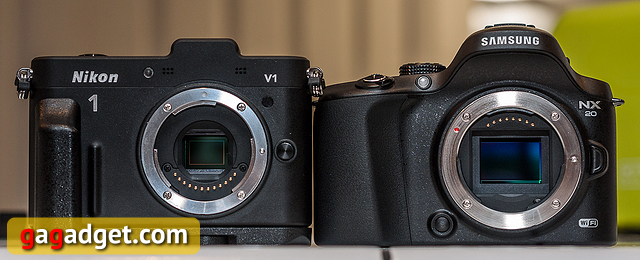
. and three times less APS-C matrices
Despite the small size of the matrix, Nikon 1 cameras provide more than acceptable image quality. I'm even ready to call it good. According to the DxOMark website, which measures the quality of matrices, Nikon 1 V1 scored the same points as Panasonic GF6 and GX1 - while Panasonic, let me remind you, has a matrix with twice the area.

Since this is not a review but an operating experience, I did not conduct formal tests. Personally, I am quite satisfied with the image quality that the Nikon 1 V1 produces up to ISO 1600 inclusive. For example, the following image was taken at ISO 1600 at a shutter speed of 1/15 (!) - it can be seen as a very impressive demonstration of both the image quality and the effectiveness of the image stabilizer in 1 Nikkor lenses.
However, I usually don’t shoot in poor lighting conditions, because I believe that photography is still light painting . I'm much more interested in a parameter called dynamic range. And here Nikon 1 turned out to be better than I thought.
The next photo was taken at sunset against the light, in addition, when shooting, I introduced exposure compensation of -1.5 stops in order to preserve as much detail as possible in the clouds and sky around the sun. As you can see, almost all the details on it are completely “faded” into black.

Let's see how much information we can extract from the shadows when processing a RAW file in Lightroom by raising the exposure by 3 stops (in this situation this is not required from a visual point of view, but it allows us to indirectly estimate the dynamic range of the camera):
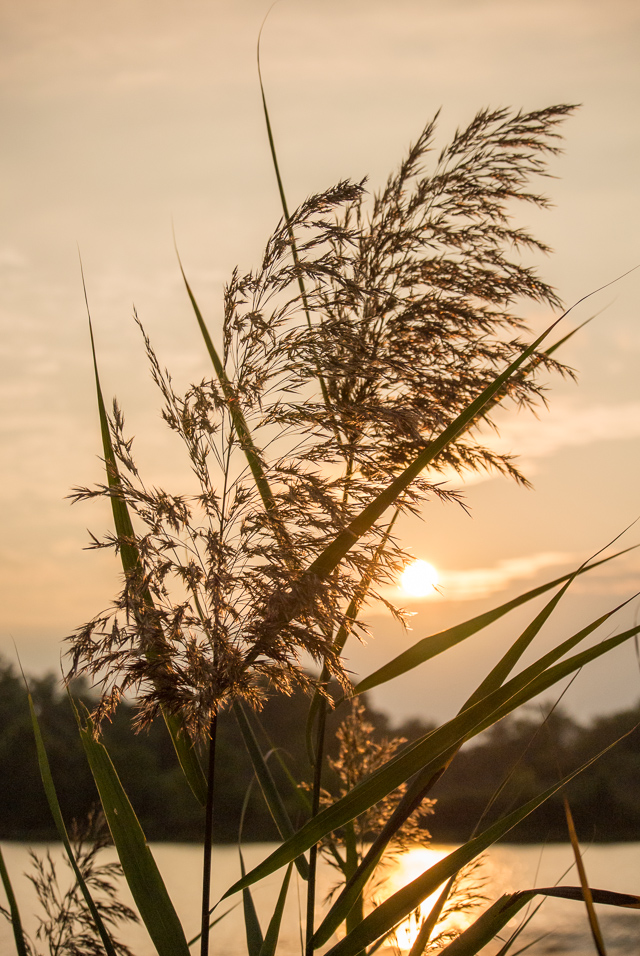
Below is a fragment of the “corrected” file at 100% scale. Despite the rather noticeable grain, detail is fully preserved.

Personally, when shooting on Nikon 1 V1, without the slightest doubt I use negative exposure compensation to preserve “highlights” and then pull out shadows from RAW files. For comparison, on Micro 4/3 cameras with Panasonic matrices this is simply impossible, because at the slightest attempt to raise the shadows, even by half a stop, a very nasty green-crimson noise emerges from them, completely eating up the details.
2. Autofocus and rate of fire
One of the main advantages of the Nikon 1 system is the best implementation of hybrid autofocus on the market with phase sensors integrated into the matrix. As a result, the Nikon 1 V1 is quite capable of competing with top-end SLR cameras in terms of autofocus speed and accuracy.
In terms of burst shooting speed, these little cameras have nothing to be shy about either. Nikon 1 V1 provides shooting in full resolution (including RAW) at a speed of 10 fps when using continuous autofocus and 30/60 fps with focus fixed to the first frame in the series.
I can’t say that I often use burst shooting, but sometimes I have to. For example, this shot was taken on a windy day; the blade of grass on which the dragonfly sat was swaying violently, so using manual focus was out of the question. As a result, I shot about 20 frames in continuous shooting mode with continuous autofocus, and then simply selected the best one.
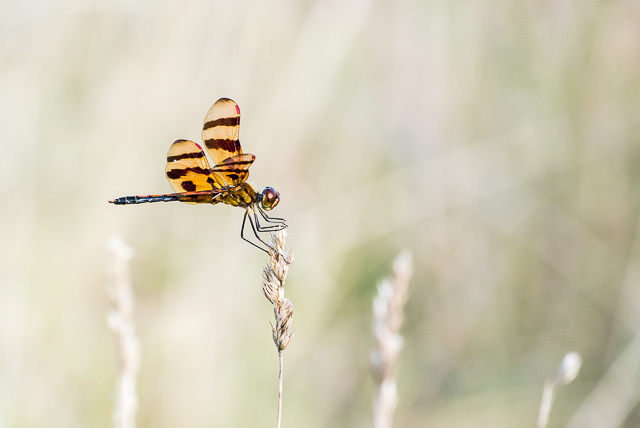
3. Camera and Lens Dimensions
Personally, I have been using exclusively mirrorless cameras for a long time because of their compactness. Nikon 1 V1 is close in size to other mirrorless cameras, as can be seen in the photographs. Personally, I don't like the soapy shape, so I use the extra grip, which makes the camera a little larger than the Samsung NX20 or Olympus OM-D E-M5.
However, the size of the camera itself is more than compensated by the size of the lenses. Both “whale” lenses have very compact dimensions. Particularly surprising in this regard, of course, is the 30-110 mm telephoto - with an EGF of 81-297 mm, it is noticeably more compact than the 18-55 mm for Samsung mirrorless cameras. By the way, this did not at all affect the optical quality of the “glasses” - they are very sharp even at the maximum open aperture and have a minimum of chromatic aberrations.

4. Video
Nikon 1 V1, like almost all modern cameras, can record video. 1920×1080/60i, 1920×1080/30p and 1280×720/60p modes are supported. The maximum bitrate is 24 Mbit/s. The camera does not support shooting at frame rates of 24, 25 or 50 fps, even in versions intended for PAL regions, and to combat the flickering of fluorescent light sources, the shutter speed during video recording is fixed at 1/100 s.
Personally, I really like how continuous autofocus works in video mode - the camera instantly refocuses on whatever is in the selected focus area, as you can see in the following video:
But the camera has a problem with tracking faces; it periodically “loses” them (although on the screen during shooting, the autofocus frame obediently follows the face):
In practice, Nikon's implementation of the AVCHD codec is very good and creates noticeably fewer visible artifacts than, say, 1080/60p with a bitrate of 28 Mbit/s in Sony cameras. Overall, I'm pleased with the quality of the video; it's enough for YouTube.
(I apologize for the jitteriness in the last video, it was almost entirely filmed with a 300 mm EFR handheld.)
5. Miscellaneous
One of the main disadvantages of mirrorless cameras, compared to DSLRs, is the short battery life, and this is due not only to relatively high power consumption due to the constantly working matrix and screen, but also to the low battery capacity. The Nikon 1 V1 uses an EN-EL15 battery with a capacity of 14 Wh (the same as the Nikon D7000). It lasts me about 600-700 frames - this is comparable to entry-level and mid-level DSLRs.
I was quite impressed with the automatic exposure control in the Nikon 1 V1 - it is absolutely foolproof. If when shooting with other cameras I very actively use exposure compensation, then when shooting Nikon 1 V1 I have to do this very, very rarely, and then in obviously difficult conditions. The same goes for white balance.
I would say that the main disadvantage of the Nikon 1 V1 is the ill-conceived controls, in particular, the stupid mode dial, which lacks basic photographic modes and loves to switch to video shooting mode on its own. I am also extremely infuriated by the need to confirm changes in all shooting parameters by pressing the “OK” button.

Another disadvantage, which is very relevant for me personally, is the lack of a standard “hot shoe”. Still, using an external flash is important both for subject photography and when managing contrast, and buying a separate flash that only works with one camera is a very dubious pleasure.
6. Test shots
As usual, full-size images can be found in a separate gallery. I warn you: since this is not a review, but an operating experience, all photographs were pre-processed in Lightroom (mostly cropping + basic color correction, without additional noise reduction).
Bottom line
I am very pleased with the Nikon 1 V1 camera and kit lenses, especially the telephoto lens, which, despite its absolutely miniature size, has excellent sharpness at all focal lengths and apertures. Moreover, at the moment I consider this system the best choice for the user who is no longer satisfied with compact cameras, but who does not want to delve deeply into photographic intricacies.
Why? Yes, because these cameras have completely impenetrable automation, excellent autofocus and at the same time very decent image quality, superior to any compact camera. Yes, the ability to control depth of field will be somewhat limited even compared to Micro 4/3. However, in my opinion, it’s high time to admit that “bokeh” in photography is far from the most important thing. Moreover, situations in which a large depth of field is necessary occur in life almost more often than the opposite. And some of the Nikon 1's features—such as ultra-high-speed continuous shooting—exceed even the capabilities of ultra-expensive professional DSLR cameras.
Personally, the Nikon 1 V1 has become my “default” camera, in the sense that I first reach for it when I need to photograph something. And this despite the fact that I have other cameras with obviously higher image quality - but they are not nearly as pleasant to use.
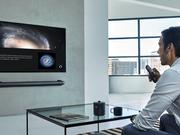
Artificial intelligence in TVs: how it works
In my opinion, the main problem with the Nikon 1 system currently is positioning and price. The system is positioned for casual users (which is correct), but in terms of price it can compete with cropped mid-class Nikon DSLRs (which is incorrect). Luckily, as generations change, these cameras start to go on sale at significantly reduced prices, making them a pretty good buy. In other words, if you need a camera and if you see a Nikon 1 V1 or J1 in the store at a price of around $300-400, buy it without hesitation.
Subscribe to our fun channel on Telegram so you don't miss anything.
Nikon 1 V3 vs Nikon 1 V2
Nikon 1 V3 is the successor to the Nikon V2, the new model has significant improvements in basic characteristics compared to the Nikon V2...
| Properties / Model | Nikon 1 V3 | Nikon 1 V2 |
| Megapixels | 18.4 megapixels | 14 megapixels |
| Sensor size/type | 1 inch (13.2 x 8.8mm) | 1 inch (13.2 x 8.8mm) |
| Low pass filter | Yes | Yes |
| Image Processor | Expeed 4A | Expeed 3A |
| Autofocus system | Contrast detection (sensor) Phase detection (Combined) | Contrast detection (sensor) Phase detection (Combined) |
| Autofocus points | 105+171 | 73+135 |
| ISO range | 160-12800 | 160-6400 |
| Shutter release min/max | 30 sec 1/16000 sec | 30 sec 1/16000 sec |
| Maximum continuous shooting speed | 60fps | 60fps |
| Video shooting | 1920 x 1080 (60, 30 fps), 1280 x 720 (120, 60, 30 fps), 768 x 288 (400 fps), 416x144 (1200 fps) | 1920 x 1080 (60 fps), 1280 x 720 (60 fps), 1072 x 720 (60 fps), 640 x 240 (400 fps), 320 x 120 (1200 fps) |
| Display | Rotatable 3-inch LCD touch screen with 921,000 pixels | 3 inch LCD screen on the back of the camera; 921,000 pixels |
| Viewfinder | No (additional option) | EVF 100% |
| Flash shoe | Yes | Yes |
| Environmental protection | No | No |
| Battery life ( CIPA) | 324 shots | 310 shots |
| Dimensions | 111 x 65 x 33 mm | 109 x 82 x 46 mm |
| Weight | 324g | 278g |
Nikon 1 V3: New sensor and image processor
The updated sensor offers a larger ISO range than the previous model, giving you better low-light images and greater resolution, while a new processor designed for the Nikon D4s DSLR (and optimized for the Nikon 1 series) incredible speed during continuous shooting.
Speed:
- The Nikon 1 V3's autofocus system is slightly more advanced, offering 105 phase-detection AF points and 171 contrast-detection AF points, while the Nikon V2 has 73 phase-detection AF points and 135 contrast-detection AF points.
- The higher resolution Nikon 1 V3 can shoot continuous shooting with full-time autofocus at 20fps, while the Nikon V2 is limited to 15fps with a slightly lower resolution.
- With full-time autofocus off: Nikon 1 V3 can shoot at up to 60fps with a resolution of 18 megapixels, Nikon V2 can also shoot at 60fps, but with a resolution of 14 megapixels.
- Nikon V3 can shoot HD video at frame rates up to 120fps, Nikon V2 is limited to just 60fps.
The Nikon V3 does not come with an EVF, but you can buy one optionally if you need one.
We strongly recommend that our users purchase the Nikon 1 V3, and Nikon V2 owners can wait until the Nikon 1 V4 is released to see significant improvements in the base specs.[/quote_box_center]

